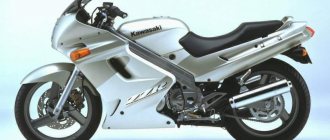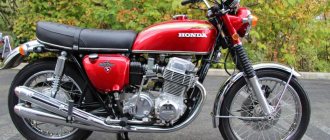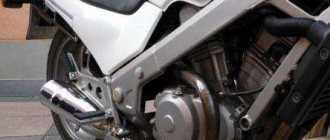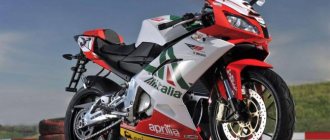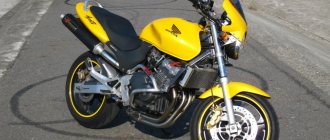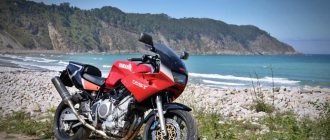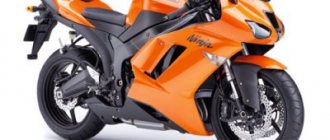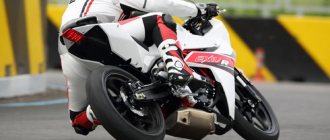The Kawasaki ER5 road motorcycle, the characteristics of which are described later in the article, occupies an intermediate place between Japanese 40 cc motorcycles and popular professional bikes. But in its properties it is closer to the first option.
This motorcycle is considered a full-fledged entry-level road device. It is as light, simple, and inexpensive as possible. That is why it is usually used by novice bikers.
general description
The model of the described motorcycle appeared in 1997. The first generation lasted until 2005. This motorcycle was built on the basis of a sports engine. It was borrowed from a bike from the same manufacturer, which is named Kawasaki GPZ500. This motorcycle received a low compression ratio, a slightly different exhaust system, and a slightly different carburetor. This model was originally intended to be sold on the European market. After new Euro-3 standards appeared, the first generation was completely discontinued. It is replaced by a Kawasaki EP6 bike.
Story
It was launched on the market in 1997, its design is truly modern compared to competitors in the sector at the time (Honda CB500 and Suzuki GS series), it undergoes some modifications in 2001, remaining unchanged until it was discontinued in 2006. Its engine is the legendary water-cooled parallel twin found in the Kawasaki GPZ 500 S (also known as EX500 or ninja 500), Kawasaki KLE trail and the custom VULCAN 500. Its Japanese version is called Balius II. but the fastenings are four-cylinder along the line and there are other minor differences.
Peculiarities
Speaking about the Kawasaki ER-5 motorcycle, which we are reviewing in this article, we need to talk about the technical characteristics. To create the vehicle, a two-cylinder engine was used, the cooling was liquid type. The power was 50 horsepower. The motor had a special even power stick. The motorcycle moved easily at low and medium speeds.
Many people like the standard design. The Kawasaki ER-5, whose technical characteristics appealed to beginners, is now officially impossible to purchase. Below we will describe the cost at which you can purchase the model secondhand. When purchasing, you need to pay attention to the condition of the suspension, engine, and examine the body for cases of deformation. This question is quite relevant. After purchase, many recommend slightly adjusting the design: installing additional parts, adding electronics, preferably replacing the brakes. We will talk about the nuances associated with them below in the article, speaking about reviews.
Overall the comments about the bike are excellent, although there are some minor issues. But those who hesitate between choosing this motorcycle and one of its competitors ultimately still prefer this model. She's much better.
Kawasaki ER-6
The new product, which appeared in 2006, appealed to both beginners and experienced riders. A simple and reliable motorcycle quickly gained popularity due to its low price and friendliness towards the “user”, and sharp tongues gave the motorcycle its own name - Ruff.
Story
In 2006, Kawasaki began selling a new 600cc machine called the ER-6 (Ninja 650 in some markets). It differed from competitors' models in its extravagant design, abundance of electronics and extraordinary engineering solutions: for example, the muffler was located under the engine, and the rear suspension shock absorber moved to the right and lay almost horizontally.
The two-cylinder transversely located injection “row” made it possible to make the motorcycle very narrow, and the considerable weight in running order (about 200 kg) was compensated by a low center of gravity and a low saddle height. The “ruff” was produced in two versions: N – naked with a minimum amount of plastic and a hooded version F, the design of which was reminiscent of the “older” models of sport bikes of the Ninja family.
Both modifications were sold both with and without ABS. In the same 2006, the closest relative of the “ruff” saw the light of day - the Kawasaki Versys crossover, which shared the same platform with the ER-6. “Versis” was distinguished by completely different plastic, a higher steering wheel and, as a result, a more upright landing.
The engine was retuned - sacrificing the “tops”, adding torque at the “bottoms” and “middle” due to different camshafts and firmware. The suspensions have changed most radically: in addition to increasing their travel, the steel rear swingarm has been replaced with an aluminum one, and the place of a conventional fork has been taken by an “upside-down” with rebound and compression adjustment.
In 2008, the brake and fork settings changed slightly, and in 2009 the instrumentation, optics and plastic of the fairing and “tail” were updated. Silent blocks appeared in the steering wheel mounts and the rear of the engine, designed to reduce vibrations and increase rider comfort, and the radiator became 40 mm wider. The design and location of the passenger handles changed, and the pendulum began to be welded from a profile with a D-shaped section instead of a rectangular one.
Since 2012, a new, radically redesigned “ruff” has appeared on the assembly line, differing from its predecessor in frame, pendulum and design. The seat height has increased by 15 mm, while the handlebars have been lowered by 10 mm, resulting in a sportier riding position. The suspension travel and the volume of the gas tank have barely noticeably increased.
For what
The ER-6 is simply made for the city: a peppy eight-valve two-cylinder in-line engine allows the narrow motorcycle to easily weave through city traffic jams, and the motorcycle will not be an outsider on the highway. Long-range “ruff” in version N is contraindicated due to poor wind protection.
“Versis”, on the contrary, is conducive to long-distance travel: an almost vertical seating position and excellent suspension with increased travel allow you to travel with pleasure even on rough roads. But you shouldn’t go off-road; after all, the Versis is a crossover, not an enduro.
“Ruffs” are chosen by both young motorcyclists, growing out of old “scabies,” and experienced ones, who have proven everything to everyone and choose a bike for every day, and, despite the solid weight of the car, representatives of the fairer sex often ride “ruffs.”
Where to look
For 8 years now, ER-6 and Versys have been in constant demand in Europe and America. Russia is not far behind, with a lot of offers in the primary and secondary markets.
The search for a “ruff” should begin by monitoring sites with advertisements for private owners, where, most likely, you will be able to find a copy that is suitable in price, condition and even color.
The picture is the same with “Versis” - despite a slightly smaller number of offers, there is plenty to choose from. If the desire to become the first owner in Russia takes over, salons selling second-hand goods from stock and to order will come to the rescue.
Choice
When choosing an ER-6, the first thing to remember is that Kawasaki conducted a recall due to burst seams where the engine brackets were welded to the frame. This is especially pronounced on cars manufactured before 2007, but even after that the problem arose periodically.
The main reason for the appearance of cracks was not a welding defect, as it might seem at first glance, but the fact that the engine with mounts turned out to be somewhat narrower than the brackets welded to the frame, as a result of which the tightly drawn ears of the mounts on the frame quickly cracked. The problem can be solved with little effort by compensating for the gap with washers and welding cracks in the fasteners. It's worth paying attention to the pump.
Tilt the motorcycle slightly onto its left side and look under the water pump housing: a leak or streaks of evaporated antifreeze will indicate a leak in the cooling system, in which case you need to find the location of the leak. As a rule, the problem is in the oil seal. Coolant enters the cavity between the pump and crankshaft seals and flows out through a tiny drain hole.
Replacing the oil seal will not be difficult, as well as the pump cover gasket, which, albeit in rare cases, also fails. Often, even on very fresh “ruffs,” problems arise with the operation of the locks, especially the gas tank lock.
Even a very poorly functioning lock can be cured with lubricant, and the gas tank lock will become easier to open if you press on the lid. At the “bride” it is worth taking a voltmeter and, spinning the engine to 3000 rpm, check the voltage coming to the battery.
If it does not fit within the specified limits of 14.2–15.2 V, you need to check the condition of the contacts on the wire chip coming to the relay regulator - often the reason lies in their oxidation. And finally, the “ruff” fuel pump is immersed in the gas tank and is cooled by its contents, so it’s better not to get carried away with driving with an empty tank.
Tuning
For comfortable operation of the “ruff” in the city, first of all, you should install a central case. A small 30-liter “case” will cost 2.5–4 thousand rubles, plus a mounting platform – another 3–5 thousand rubles. You can protect the motor from falls with sliders or arches (3–8 thousand rubles), and hand protection will protect your hands from stones (3–5 thousand rubles).
During the runs, a high windshield (1.5–6 thousand rubles) and heated steering wheel grips (from 2.5 thousand rubles) will be useful. In addition, aftermarket manufacturers offer many very useful accessories, such as a front fender extension and a lowered seat.
Advantages and disadvantages
The Kawasaki ER-5 motorcycle, the price of which is quite low, which is considered an advantage, had a cheap steel frame. Buyers considered this a minus. The shock absorber was installed as a double shock absorber, of the classic type. It was located at the back. Drum brakes could also be found there. Even at the time the motorcycle was created, such solutions were already outdated, so many buyers did not understand the point of creating such a vehicle.
But among the main advantages, in addition to low cost, it is necessary to highlight the unpretentiousness of the engine and easy maintenance of the motorcycle. It is thanks to this quality that this bike has become quite famous in Europe. The average fuel consumption of the Kawasaki ER-5 is up to 5.5 liters per 100 km.
Modernization
The Kawasaki ER-5 motorcycle (reviews below) has been modernized several times. For example, in 1998 the R5 ventilation system was installed. It had 4 hoses, and the clutch lever and fuel gauge had a different stroke. In 2001, the tail was changed and the fuel tank was improved, which received a volume of 17 liters. Moreover, these changes complemented a number of other, less significant ones. In 2004, the motorcycle received a catalyst. Thanks to this, power was reduced to 49 horsepower. Models produced at this time received black rims and mirrors with plastic protection. In 2005, a stainless steel exhaust pipe was installed on the motorbike.
Suzuki GS 500
This motorcycle is considered one of the main competitors of the vehicle described in the article. The history of this bike began in 1989. Unlike the model described above, it is still produced to this day. They are creating it for South America. Initially, it focused on the European and US markets. However, after the crisis they began to produce it for South America. The peculiarity of the motorcycle is that it has a 2-cylinder engine, air-cooled. The power of the motorcycle is 45 horsepower. The motor is outdated, but when driving it shows itself perfectly.
The model does not have any special features. Got a steel frame, simple pendants. The gearbox is equipped with 6 steps. Dry weight is 169 kilograms. The cost of this used motorcycle in the Russian Federation reaches 80 thousand rubles. Fuel consumption per 100 km is almost 5 liters.
Driving
Its ride is easy, its engine is a bit rough, but on the other hand it has enough engine brake, the nobility of the whole is felt over time, and it is currently one of the favorites of the motorcycle school before acquiring larger displacement motorcycles. Few brakes and narrow tires limit the kit for sports touring use, preferably without a passenger. Its flexible engine, lightness and good chassis make it a good bike for use in the city and on winding, well-surfaced roads.
Honda CBF 500
Another close competitor to the model described above is the Honda CBF500. It appeared in 2004. We made this motorcycle so that it could be released on the market of European countries. It complies with Euro 2 standard. This model has many features. For example, the design was truly modern by 2004 standards. There is an instrument panel with a digital display. The wheel size is considered standard. The frame is made using a motor connected to a supporting element. The brake system is used combined. There is a 3-piston caliper in gold color. A central monoshock absorber is used, instead of a double shock absorber on the sides. And the fuel tank has a volume of 19 liters. This model in the Russian Federation with mileage is sold for 200 thousand rubles. Fuel consumption is 4 liters per 100 km. But this is according to the manufacturer. But buyers report that, as a rule, the consumption is 5 liters.
Honda CB 500
The last official competitor of this motorbike is the Honda CB 500. The first generation was created in 1924. The motorcycle was produced until 2002. This model, as a rule, was supplied to the European market. Low cost, simplicity and reliability made the motorcycle quite famous. It is often used in courier services. This bike is powered by a 2-cylinder engine and is liquid cooled. Power is 57 horsepower. The maximum speed reaches 193 km/h. The equipment is completely simple. Brakes are disc type. The suspension was telescopic. The fuel tank is designed for 18 liters. Dry weight is 170 kg.
In 2002, this model was discontinued. The reason was that the Euro-2 standard had been updated, so the motorcycle could no longer be sold. The cost of this bike in good condition without mileage is about 5 thousand dollars. With mileage this amount equals 110,000 rubles. Fuel consumption reaches 6 liters per 100 km.
Specifications [1]
- Displacement: 498 cc.
- Power: 37 kW (50 hp) 9000 rpm
- Engine steam: 45 Nm (4.6 kgfm) 7,200 rpm
- Engine type: 4T DOHC
- Cylinders: 2
- Diam. × stroke: 74 × 58 mm
- Compression ratio: 9.8:1
- Power: 34mm Kehin CVK carburetors
- Liquid cooling
- Ignition: electronic CDI
- Electric start
- Clutch: multi-plate in oil bath
Cycle
- Chassis: Double cradle
- Material: tubular steel
- Extension: 102 mm
- Start: 27°
- Front suspension: hydraulic telescopic fork
Diam. Rods: 37mm Travel: 125mm Settings: No
- Rear Suspension: Double adjustable shock absorber
Travel: 115mm Settings: 5 in spring preload
- Front brake: disc and two-piston caliper
Diameter 280 mm Drive: Hydraulic
- Rear Brake: Drum
Diameter: 160 mm Drive: mechanical
- Front tire: 110/70×17
- Rear tire: 130/70×17
dimensions
- Length: 2070 mm
- Wheelbase: 1430 mm
- Anchura: 1070 mm
- Seat height: 780 mm
- Curb weight: 174 kg
- Tank capacity: 17
Reviews
The Kawasaki ER-5 road motorcycle (specifications above), which was described in this article, is considered very reliable. However, it does not shine with any special features. A liquid cooling system was inserted into the Kawasaki ER-5's steel frame. We're talking about the motor. It is perfectly balanced, due to this the acceleration is quite smooth and fast. As mentioned above, the power of this model is 49 horsepower. The power supply is injection type, although previously there was a carburetor. The gearbox operates with 6 steps. Acceleration from 0 to 100 km/h takes 6 seconds. This indicator does not please many drivers, but in defense of this motorbike we can say that acceleration occurs smoothly.
It should be noted that the same engine was installed on the famous Kawasaki EN500 chopper. The maximum speed of this bike was 180 km/h. What can be said about external factors? The design data of the model are considered classic. The bike has round headlights and minimal plastic bodywork. This style has always been popular and still remains so. Therefore, the external design and overall design can be called successful.
If we also take into account the excellent reputation of the manufacturer and the reliability of the motorcycle itself, then we can call it an interesting and best option. Of course, there are some force majeure events and factory defects. Moreover, many Kawasaki motorcycles have problems with the gearbox. It should be noted that this problem has been eliminated in this motorbike. Therefore, this motorcycle turned out to be light and quite fast. It's easy to use. For everyday use, it is no worse suited than any other popular motorcycles from Honda.
The suspension of this device is classic, has a fork at the front and shock absorbers at the rear. This does not cause any special emotions in the driver. Many people say that there are still no differences. Overall it works quite well. The rear shock absorber protection regulates the spring preload, so each driver can customize their performance. Many people express their dissatisfaction with the brakes. Unfortunately, drum brakes have not been used for a long time, as they are considered obsolete. The front wheels are equipped with disc wheels. They are not bad, but many do not understand the logic of installing different brakes on both wheels.
The strengths of this motorcycle include handling, even though the total weight is 175 kg. It is noted that this motorbike does not have powerful characteristics, it is simple and is perfect for all beginners. Thanks to the excellent gas tank, which is designed for driving in the city, you can travel well over long distances.
Unfortunately, it’s disappointing that this motorcycle doesn’t have its own flair. Of course, no one demands to amaze buyers with unimaginable elements, but many argue that the design could have been made more beautiful or some additional options could have been installed. In general, this model is more suitable for beginners; this motorcycle has not gained much popularity among professional buyers and bikers. But those who have used this vehicle recommend it to many and, at least for the sake of interest, advise driving it.
Review of the Kawasaki ER-5 motorcycle
The first sensations are the same Java, but more than twice as powerful and a little heavier. It steers easily and naturally, the weight distribution (as it seemed to me) is close to 50/50. Your hands don’t get tired of turning the steering wheel, the seating position is comfortable, and the clicks are also not like the oak levers of an Izh. My lame mistake - you don’t need to steer the motorcycle, you need to lay it down, if you had laid it down and not tried to turn the steering wheel, then the Sabotage would not have seemed difficult. But this understanding came later, but for now - hello, the first Japanese motorcycle.
pros:
1. Management.
It's easy to steer. It goes into turns without any problems, it forgives mistakes - which is very important for the first motz. In general, it behaves predictably. 2. Landing. The fit is classic, not very high, comfortable. Glass will relieve the load on your hands and head and allow you to comfortably ride at a speed of 120 for medium and long distances. I installed glass from Givi for 30Ls (it didn’t work for one friend) - the average speed increased to 150km/h. You just go and don’t stress. When I drove without glass, I got used to feeling the speed by the wind resistance, I put the glass on and almost got hit a couple of times - already in the turn I realized that it would be difficult to go into the turn, a glance at the speedometer - well, what do you want, my friend: 130 km/h ...
3. Engine. Motor from a washing machine. Installed on choppers (EN-500), classics EP-5 and endurniks KLE-500, and with some changes, it seems, on the GPZ-500. When you’re driving alone, it’s enough, but if you’re with a passenger, it’s not enough—it doesn’t pull, you want to get off and push. You will feel the lack of power when you overtake a column of cars going 110-120 - there can be no talk of any jerk, only smooth, unhurried acceleration. In general, the motor is not bad, for a quiet ride it’s almost according to the rules. The engine is also an advantage because the motor is popular in motorcycle schools, and this, you see, already says something.
4. Consumption. at 120-130 approx. 4.5 - 5 liters. Depends on the wind - headwind or tailwind.
5. Its price - it is inexpensive, cheaper than the Honda CB-500 - a direct competitor, although it has a disc brake at the rear, which is already a plus for it...
cons:
1. brakes.
If you don't anneal it, then the front disc is quite enough. “The brakes match the dynamics of the motorcycle” - exactly. It’s unlikely that you’ll be able to make stoppie, although I haven’t tried it. 2. vibrations after 5 thousand rpm. I wouldn’t say that they were very annoying, but not pleasant... BUT, everyone has them. Some have more, some have a little less. The minus of vibrations is that in 6th gear 5 thousand rpm is 110 km/h, so in order to get rid of the unpleasant feeling you need to drive either slower, which you hardly want, or faster - for this you should splurge on glass, otherwise your hands get tired. And it is at 5 thousand that the motorcycle begins to move; everything before that can be considered idling. Honda CB has the same problem.
3. I didn’t like the position of the candles - they sit very deep and in order to unscrew them you must first pick out/blow out/scrape out the dirt and sand around them. Although this can be done once a year.
The general impression is that it’s a good motz to start with. It doesn’t provoke you to burn out, you can push (as far as the engine allows), but then you return to a calm rhythm. Comfortable speed is 120-130 (I have a speedometer in miles, I drive about 80 mph). Maximum speed , which I gained 115 miles (185 km), I don’t know how much the speedometer was lying. I constantly raced with the Diversion of '98 - it accelerates a little faster, but somehow it’s not impressive, the EP looks quite decent against its background. It’s a good bike to ride, think and decide what you need. You can drive along the highway a la Rossi, you can just take a leisurely drive around the neighborhood, or you can drive along forest paths, where you wouldn’t even go on a sport bike. Together with Diversion, I have traveled hundreds of kilometers on such trails. — 140 km/h on forest gravel is nowhere near 180 on asphalt...
my ep5 2007 issue. Bought in 2008 with 900 km mileage. I've had it for 3 years, driven 10,000 km, not a single breakdown. in the cold (+5) it starts with a choke at half a turn (I drive it in winter (to work and back), although winters here in Italy below zero are rare, I’m not far from the sea). catalyst in the plug (you need lead-free gasoline)
Gasoline consumption - when refueling at 12 liters. I drive 290-320 km (city-highway) at max. speed is 100-110, if you drive it, of course it’s more. (good gasoline and roads without holes probably also have an effect) it turns out about 4 liters per 100 km
I have it on the street (near the house) - it’s normal here (there’s no garage - what can you do!!) and nothing has rusted or corroded during all this time
with electrical There are no problems yet and the battery is spinning normally
The old naked Kawasaki ER-5 with a parallel-twin engine is a workhorse for the city and suburbs. A motorcycle is designed to get from point A to point B, and nothing more.
The Kawasaki ER-5 engine has very modest parameters: power 48 hp. and torque 45 Nm. The full potential of the engine can be squeezed out within the city. The Kawasaki ER-5 is far from an ideal highway bike, with weak power and lack of fairing taking its toll.
The Kawasaki ER-5 is better than some of its competitors, but it's a long way off from the Honda CB500. The ER-5's braking system is the saddest part of the motorcycle, but the pilot's seating position is relatively comfortable.
As for the quality of the Kawasaki ER-5, it can be described in one word - “bad”. Firstly, no matter where you look, corrosion can appear everywhere; it’s worth regularly inspecting and washing your motorcycle. Secondly, electrical problems are common with the Kawasaki ER-5.
This was my first motorcycle. He is a neoclassical handsome man. I could endlessly admire his forms and I liked him madly. I bought it as a gift for the New Year 2005 in December 2004 with a mileage of 2700 km. From the end of May 2005 we began to get used to each other. Every day to work and back, 70-100 km a day. Fuel consumption (92 petrol) is around 5l/100km. The tank volume is 17 liters, so after 230 km I was already looking for a gas station. The maximum speed is 190 km/h according to the speedometer, I accelerated like that once. A comfortable speed on a country highway is 120 km/h, above that the wind already presses into your chest, you want to lie down on the tank, but with a fairly high steering wheel, the posture turns out to be somehow wrong. I ordered a small windshield and waited more than a month. The appearance of the device has changed for the worse, but the problem remains. I ordered roll bars in June, they cost 4,500 rubles, but I waited until the end of the season, I received them when the motorcycle was parked for the winter. Before this, two right halves arrived once. I used semi-synthetic Liqui Molly 10w40 as oil, changed it every 5,000 km, and changed the filter every 10,000 km. In general, everything is according to the instructions. Even the spark plugs failed according to the instructions, after 10,000 km. I installed a Moto Line alarm. The installers' careless attitude to insulating connections led to blown turn signal fuses. At first I couldn’t understand what was happening until one day I removed the saddle immediately after washing the motorcycle, I saw sparks where the wires touched the frame and everything became clear. What I like about a classic motorcycle is easy access to all components, so I was happy to perform simple operations - changing oil, antifreeze, brake fluid, pads, spark plugs myself. I would like to note the relative cheapness of motorcycle maintenance. Rubber, pads, oil - everything is budget. And falls were almost free for me (even without arches), but with arches it was generally harmless. However, after falling on the right side, the exhaust pipe had to be welded because even a non-original one costs 350-400 euros. After one unpleasant incident - the motorcycle was standing near the Motoextreme store on Pionerskaya Street, a person in a Mercedes was backing out and hit it - I had to order the right part of the shank, a piece of plastic - 150 euros. By the way, in this case, I looked at the motorcycle, started it, everything was fine and said goodbye to the guys on the gelding without involving the traffic police, and I only saw that the plastic was broken later, because these “I don’t even know what to call them” collected the wreckage on the sly so that I wouldn’t notice.
I felt well the difference between the four-cylinder ones (Honda SV-400, Suzuki Bandit 400) and my two-cylinder one. What is it? The four-cylinders need to be revved up harder to achieve the same speed as the ER-5 and feel more sporty. You ride a hundred on the Bandit, but it feels like you’re dumping two kopecks. And on the Kawasaki ER-5 you go 120 km/h while walking, a more “torque” motorcycle. At low speeds I didn’t like the “torque”; I preferred the smoothness of four-cylinder engines. But Kava’s sound is more motorcycle-like. In autumn and early spring there is not enough heating of the steering wheel grips.

